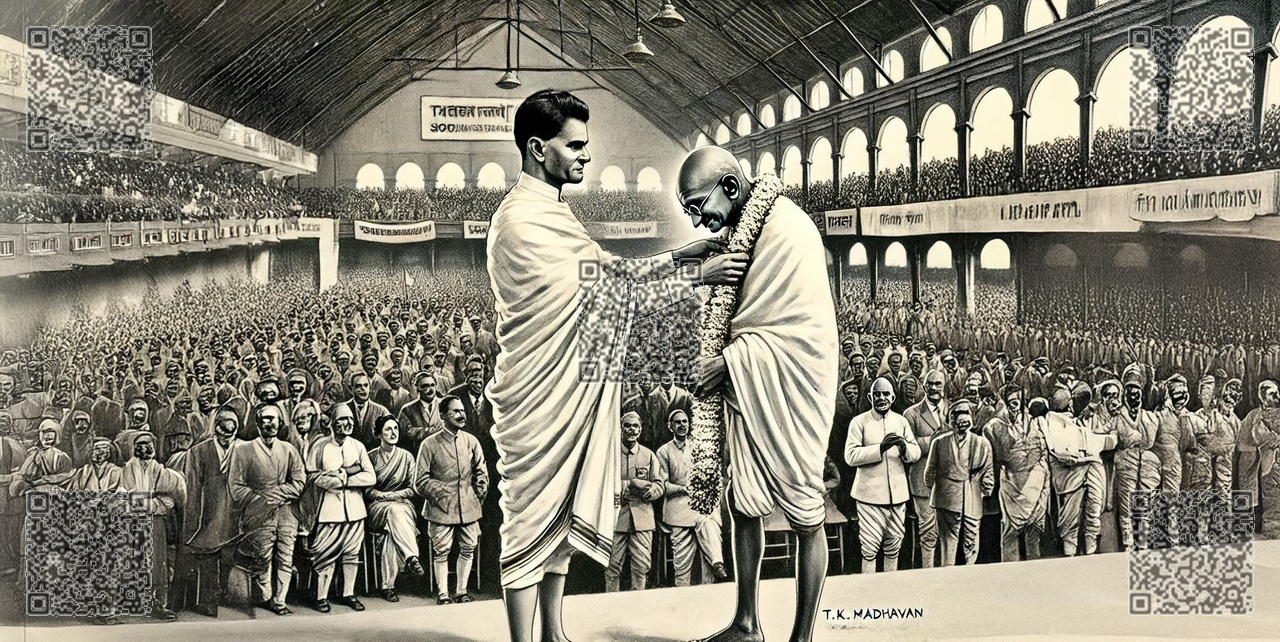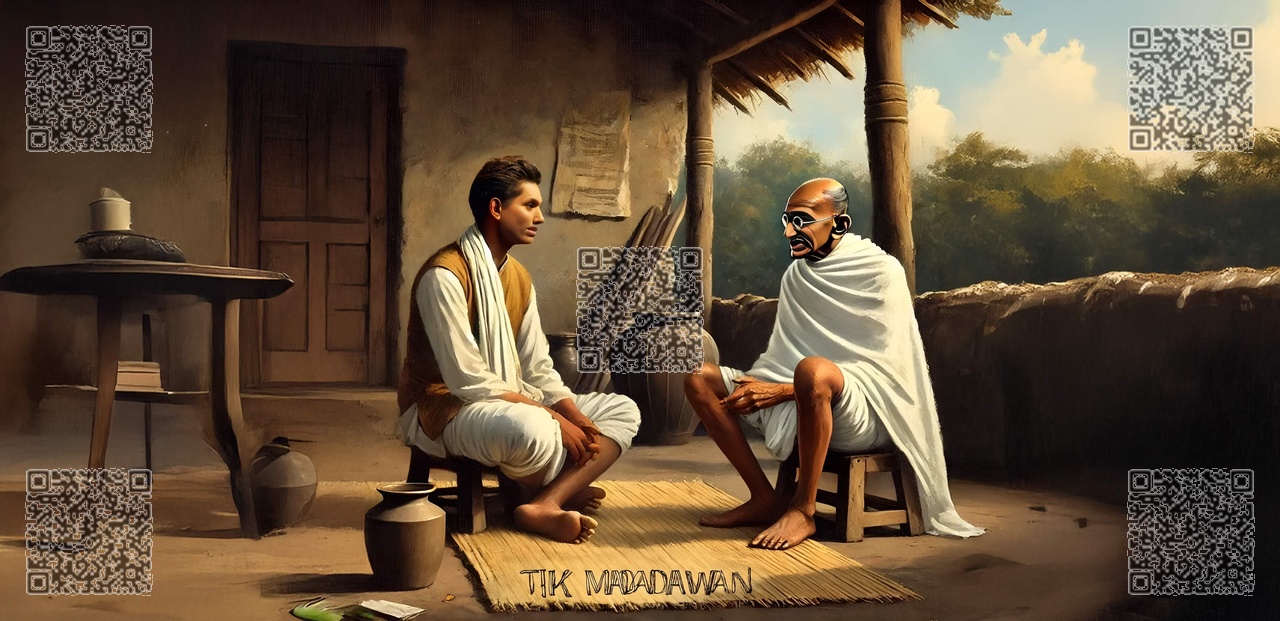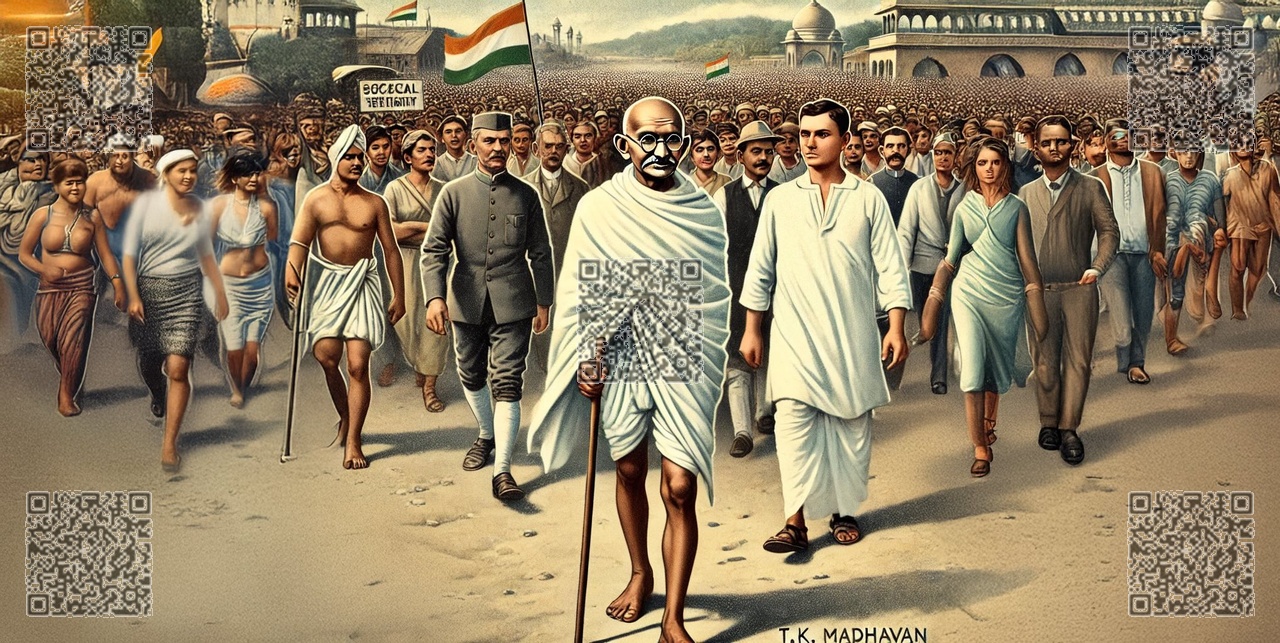Meeting with Mahatma Gandhi
T.K. Madhavan (Deshabhimani), a staunch Gandhian, devoted his life to eradicating untouchability in Kerala. In 1921, at Tirunelveli, he met Mahatma Gandhi and secured his support for the temple entry movement. During this meeting, Madhavan informed Gandhi about Kerala’s harsh caste-based social structure and the struggles of the marginalized communities. This meeting became a turning point in Kerala’s history. Madhavan encouraged Gandhi to address untouchability directly with the people of Kerala and to visit Vaikom to support the ongoing struggle. Gandhi agreed and incorporated the issue into the Indian National Congress agenda. His visit to Vaikom significantly influenced the cause. In November 1925, all castes, including Ezhavas and other backward communities, were granted the right to walk on temple roads.

Madhavan, a member of the Alummoottil family, and a skilled orator, was one of the chief architects of the Vaikom Satyagraha. In 1923, he participated in the Kakinada session of Congress alongside P. Kesava Menon and Sardar K.M. Panikkar. There, Madhavan spoke about the issue of untouchability in Kerala to leaders such as Maulana Mohammad Ali, C.R. Das, and C. Rajagopalachari, earning strong support from the All India Congress leadership. Before this, he had already established a rapport with Gandhi. The 1924 Belgaum Congress, chaired by Gandhi, passed a resolution supporting the Vaikom Satyagraha, strengthening the movement’s momentum.

Madhavan was a prominent organizer of Kerala’s social reform movements. From 1918 to 1920, he served as a member of the Travancore Legislative Council. On January 24, 1924, the Kerala State Congress Committee convened in Ernakulam, where anti-untouchability was declared an urgent issue. K Kelappan led the committee in spearheading action. Madhavan also attended the 1925 Kanpur Congress session, continuing his efforts to prioritize temple entry and uplift marginalized communities. His core belief was that progress should include not just his community but all oppressed groups. He often declared, “My religion is Indian politics,” crediting Sri Narayana Guru’s teachings for inspiring him.

Madhavan’s ability to communicate his ideas and build consensus set him apart. Gandhi deeply admired him, describing him as a “leader of remarkable ability.” Madhavan’s organizational brilliance helped transform the Vaikom Satyagraha into a national movement. His efforts also led to the historic opening of the Ambalappuzha temple to marginalized communities. However, his relentless work took a toll on his health. Madhavan suffered from heart disease and later typhoid, but he continued his activism undeterred.
On April 27, 1930, Madhavan passed away at 44. His death was a significant loss to Kerala and the national reform movement. Sardar K.M. Panikkar mourned him as a rare leader with unmatched courage, integrity, and organizational skills. Prominent leaders such as Pandit Motilal Nehru, Madan Mohan Malaviya, and M. Krishnan Nair also paid tribute to him.
When Gandhi visited Kerala in 1934, he inquired, “Where is Madhavan, who was part of the Vaikom Satyagraha?” Upon hearing of Madhavan’s death, Gandhi expressed sorrow, noting that he had been in his thoughts since his first visit to Kerala. At the time of Madhavan’s death, Gandhi was fasting in Yerwada Jail, and the authorities had withheld the news from him.
Madhavan’s legacy includes writings such as Temple Entry, Dr. Palpu’s Biography, Haridasi (a translation), and My Jail Life. The T.K. Madhava Memorial College in Nangiarkulangara, established in 1964, honors his contributions. His name remains etched in Kerala’s history as a symbol of the Renaissance and social reform, paving the way for equality and justice.
ഗാന്ധിജിയുമായുള്ള കൂടിക്കാഴ്ച
അടിയുറച്ച ഗാന്ധീയനായിരുന്ന അദ്ദേഹം കേരളത്തിലെ തൊട്ടുകൂടായ്മ നിർമാർജനത്തിനായി തന്റെ ജീവിതം ഉഴിഞ്ഞുവച്ചു. 1921-ൽ തിരുനെൽവേലിയിൽ വെച്ച് അദ്ദേഹം ഗാന്ധിജിയെ കാണുകയും ക്ഷേത്രപ്രവേശന പ്രക്ഷോഭത്തിനു അനുകൂലമായ ഒരു സന്ദേശം വാങ്ങുകയും ചെയ്തു. കേരളത്തിലെ ദയനീയമായ, ജാതീയമായ സാമൂഹിക സാഹചര്യത്തെക്കുറിച്ചും കേരളത്തിലെ താഴ്ന്ന ജാതി സമൂഹങ്ങളുടെ അവസ്ഥയെക്കുറിച്ചും അദ്ദേഹത്തെ അറിയിച്ചു.1921 സെപ്തംബർ 24-ന് തിരുനെൽവേലിയിൽ വെച്ച് ടി.കെ മാധവൻ ഗാന്ധിജിയുമായി നടത്തിയ കൂടിക്കാഴ്ച കേരള ചരിത്രത്തിലെ തന്നെ വഴിത്തിരിവായി തീർന്നു . തൊട്ടുകൂടായ്മയ്ക്കെതിരായ തന്റെ നിലപാടിനെക്കുറിച്ച് കേരളത്തിലെ ജനങ്ങളെ അഭിസംബോധന ചെയ്യാൻ മാധവൻ ഗാന്ധിയെ പ്രേരിപ്പിച്ചു. വൈക്കം സന്ദർശിക്കാനും പ്രസ്ഥാനത്തെ പിന്തുണയ്ക്കാനും അദ്ദേഹം ഗാന്ധിയെ പ്രേരിപ്പിച്ചു.. ഇന്ത്യൻ നാഷണൽ കോൺഗ്രസിന്റെ അജണ്ടയിൽ ഈ വിഷയം ഉൾപ്പെടുത്താൻ ഗാന്ധി സമ്മതിച്ചു . ഗാന്ധിയുടെ വൈക്കം സന്ദർശനം കാര്യമായ സ്വാധീനം ചെലുത്തി. 1925 നവംബറിൽ ഈഴവരും മറ്റ് പിന്നോക്ക സമുദായങ്ങളും ഉൾപ്പെടെ എല്ലാവർക്കും ക്ഷേത്രവഴികളിലൂടെ നടക്കാൻ അനുമതി നൽകി. മഹാത്മാഗാന്ധി കേരളം സന്ദർശിക്കാനും അന്നു മുതൽ ക്ഷേത്രപ്രവേശനത്തിന് അനുകൂലമായ നിലപാട് എടുക്കാനും കാരണം തീർച്ചയായും ഈ കൂടിക്കാഴ്ച ആയിരുന്നിരിക്കണം.
പ്രസംഗിക്കുന്നതിൽ മിടുക്കനായിരുന്ന ശ്രീ ടി. കെ. മാധവൻ വൈക്കം സത്യാഗ്രഹത്തിന്റെ സൂത്രധാരന്മാരിൽ പ്രധാനിയായിരുന്നു. 1923-ൽ കാക്കിനാഡയിൽ സമ്മേളിച്ച കോൺഗ്രസ്സിൽ പി. കേശവ മേനോൻ, സർദാർ കെ. എം. പണിക്കർ എന്നിവരോടൊപ്പം പങ്കെടുത്തു.അദ്ധ്യക്ഷത വഹിച്ച മൗലാനാ മുഹമ്മദ് അലി, സി.ആർ. ദാസ് , സി. രാജഗോപാലാചാരി തുടങ്ങിയ പ്രമുഖന്മാരുമായി കേരളത്തിലെ അയിത്തത്തെക്കുറിച്ച് സംസാരിച്ചു. ഈ സമ്മേളനത്തിലൂടെ അദ്ദേഹം അയിത്തോച്ചാടനത്തിനു അഖിലേന്ത്യ കോൺഗ്രസ് നേതൃത്വത്തിന്റെ ഉറച്ച പിന്തുണ നേടിയെടുത്തു. അതിനു മുൻപ് തന്നെ ഗാന്ധിജിയുമായി പരിചയപ്പെട്ടിരുന്നു. 1924-ൽ കൂടിയ ബൽഗാം കോൺഗ്രസ്സിലും അദ്ദേഹം സംബന്ധിക്കുകയുണ്ടായി. മഹാത്മാഗാന്ധിയായിരുന്നു യോഗാദ്ധ്യക്ഷൻ. ഈ സമ്മേളനത്തിൽ വൈക്കം സത്യാഗ്രഹത്തെ പറ്റിയുള്ള പ്രമേയം ഗാന്ധിജിയാണ് അവതരിപ്പിച്ച് പാസ്സാക്കിയത്. അദ്ദേഹം മികച്ച സംഘാടകനായിരുന്നു. 1918-20 കാലഘട്ടത്തിൽ തിരുവിതാംകൂർ പ്രജാസഭാമെംബറായി പ്രവർത്തിച്ചു. 1924 ജനുവരി 24 നു എറണാകുളത്തു കൂടിയ കേരളാ സംസ്ഥാന കോൺഗ്രസ് കമ്മിറ്റിയുടെ യോഗം അയിത്തോച്ഛാടനം ഒരു അടിയന്തര വിഷയമായി പരിഗണിച്ചു ഉചിതമായ നടപടികൾ സ്വീകരിക്കുന്നതിന് ഒരു സമിതിയെ നിശ്ചയിച്ചു. കെ കേളപ്പൻ ആയിരുന്നു കൺവീനർ.1925 ലെ കാൺപൂർ കോൺഗ്രസ്സിലും അദ്ദേഹം സംബന്ധിച്ചു.സ്വന്തം സമുദായത്തിനൊപ്പം സഹോദര സമുദായങ്ങളും നന്നാകാൻ പ്രവർത്തിക്കണമെന്നതായിരുന്നു ടി കെ മാധവന്റെ ജീവിത സന്ദേശം. “ എന്റെ മതം ഇന്ത്യൻ രാഷ്ട്രീയ മതമാകുന്നു. ഇന്ത്യയുടെ ഉയർച്ചയ്ക്കും ഉണർവിനും വേണ്ടിയുള്ള പ്രവർത്തികളാണ് താൻ ചെയ്യാൻ ആഗ്രഹിക്കുന്നതെന്നും ശ്രീനാരായണഗുരു സ്വാമികളുടെ ഉപദേശം ഈ വിഷയത്തിൽ എന്നെ വളരെ സഹായിച്ചിട്ടുണ്ടെന്നും “ അദ്ദേഹം ദേശാഭിമാനിയിലൂടെ ലോകത്തോട് വിളിച്ചു പറഞ്ഞിട്ടുണ്ട്.
അനീതിക്കെതിരായ തീപ്പൊരി വീഴുന്നത് ചില ത്യാഗ മനസ്സുകളിൽ ആണ് .അതിനെ കഠിനപ്രയത്നത്തിലൂടെ ഉലയൂതി എടുക്കുമ്പോഴാണ് സാമൂഹിക വിപ്ലവം സാധ്യമാകുന്നത്. ദേശീയ പ്രസ്ഥാനത്തിന്റെ, മഹാത്മാഗാന്ധിയുടെ, പിന്തുണയോടെ പോരാടാൻ ആണ് അദ്ദേഹം ഉറച്ചത്. കോൺഗ്രസുമായി ബന്ധപ്പെട്ട എല്ലാ സഹായവും ചെയ്തു കൊടുക്കാൻ സർദാർ കെ എം പണിക്കരും സന്നദ്ധനായി. ആദ്യമായി പങ്കെടുത്ത കാക്കിനാഡ സമ്മേളനത്തിൽ തന്നെ തന്റെ നിലപാടുകൾക്ക് അനുകൂലമായ നയം കോൺഗ്രസിനെ കൊണ്ട് അംഗീകരിപ്പിക്കാൻ അദ്ദേഹത്തിന് കഴിഞ്ഞു. എവിടെയും കടന്ന് ചെല്ലാനുള്ള തന്റെ ഇടവും , എന്തും പറഞ്ഞ് ബോധ്യപ്പെടുത്താനുള്ള കഴിവും അദ്ദേഹത്തിന്റെ സവിശേഷതയായിരുന്നു. മാധവനോട് ഗാന്ധിജിക്ക് അതിരറ്റ വാത്സല്യം ഉണ്ടായിരുന്നു. “ അൽഭുതാവഹമായ പ്രവർത്തനശേഷിയുള്ള നേതാവ്” എന്നായിരുന്നു ടി. കെ .മാധവനെ ഗാന്ധിജി വിശേഷിപ്പിച്ചത്. ഇന്ത്യൻ നാഷണൽ കോൺഗ്രസിന് മാത്രമല്ല ഇന്ത്യയെ മുഴുവൻ തന്നെ വൈക്കം സത്യാഗ്രഹത്തിന്റെ ഭാഗമാക്കിയത് മാധവന്റെ അത്ഭുതകരമായ കർമ്മകുശലതയാണെന്ന് സഹോദരൻ അയ്യപ്പൻ വിലയിരുത്തി.
നായരീഴവ രാഷ്ട്രീയ സഖ്യത്തിന്റെ പ്രതീകമായി അദ്ദേഹം കരുതപ്പെട്ടു. അമ്പലപ്പുഴ ക്ഷേത്രം അവർണ്ണർക്കായി തുറന്നു കൊടുത്തതിനു പിന്നിലും ടി.കെ. മാധവൻ ഉണ്ടായിരുന്നു.ഇതിനിടെ അദ്ദേഹത്തിന് ഹൃദ്രോഗവും ബാധിച്ചിരുന്നൂ. പിന്നീട് പനിയും അതിസാരവും ബാധിച്ചു. എന്നാൽ രോഗത്തെയും അവഗണിച്ചുകൊണ്ട് അദ്ദേഹം സംഘടനാ പ്രവർത്തനങ്ങളിലും മറ്റും മുഴുകി.1930 ഏപ്രിൽ 27 ന് വെളുപ്പിന് 4:55 ന് അദ്ദേഹം അന്തരിച്ചു.മരിക്കുമ്പോൾ അദ്ദേഹത്തിന് 44 വയസ്സേ ഉണ്ടായിരുന്നുള്ളു. “മാധവന്റെ മരണം മൂലം മലബാറിന് അസാമാന്യമായ ധൈര്യവും സംഘടനാവൈദഗ്ദ്ധ്യവും ഉദ്ദേശശുദ്ധിയുമുള്ള ഒരു സമുദായ പരിഷ്ക്കർത്താവിനെ നഷ്ടമായി” , എന്ന് സർദാർ കെ.എം. പണിക്കർ അനുശോചനമറിയിച്ചു .നിരവധി നേതാക്കന്മാർ അദ്ദേഹത്തിന്റെ ശവസംസ്കാരത്തിൽ പങ്കെടുത്തു. അനുശോചനമറിയിച്ച പ്രമുഖരിൽ പണ്ഡിറ്റ് മോത്തിലാൽ നെഹ്റു, മദൻ മോഹൻ മാളവ്യ , എം. കൃഷ്ണൻ നായർ എന്നിവരും ഉൾപ്പെടുന്നു.
“വൈക്കം സത്യാഗ്രഹത്തിൽ ഉണ്ടായിരുന്ന മാധവൻ ഇപ്പോൾ എവിടെയുണ്ട്?”, 1934- ൽ കോഴിക്കോട് വന്നപ്പോൾ മഹാത്മജി ചോദിച്ചു. “മാധവൻ മരിച്ചു പോയല്ലോ, അക്കാര്യം അറിഞ്ഞില്ലെ?” എന്ന് അവിടെയുണ്ടായിരുന്നവർ തിരക്കിയപ്പോൾ ഗാന്ധിജി ദുഃഖിതനായി. മാധവന്റെ ചരമവാർത്ത അറിയിക്കുമ്പോൾ ഗാന്ധിജി യേർവാഡ ജയിലിൽ ആയിരുന്നു. ഉപവാസത്തിൽ ആയിരുന്ന അദ്ദേഹത്തിന് അധികൃതർ ആ സന്ദേശം കൈമാറിയില്ല. കേരളത്തിൽ കാലെടുത്തുവച്ചത് മുതൽ താൻ മാധവനെ പറ്റി ചിന്തിച്ചു കൊണ്ടിരിക്കുകയായിരുന്നു എന്ന് അദ്ദേഹം സങ്കടത്തോടെ പറഞ്ഞു.
ടി.കെ മാധവന്റെ പ്രധാന കൃതികൾ ആണ് ക്ഷേത്രപ്രവേശനം, ഡോ. പല്പു - ജീവചരിത്രം, ഹരിദാസി (വിവർത്തനം), എന്റെ ജയിൽ വാസം എന്നിവ .ആലപ്പുഴയിലെ ഹരിപ്പാടിനടുത്ത് നങ്ങ്യാർകുളങ്ങരയിൽ സ്ഥിതിചെയ്യുന്ന കലാലയമാണ് ടി.കെ. മാധവ മെമ്മോറിയൽ കോളേജ്.അദ്ദേഹത്തിന്റെ സ്മരണാർത്ഥം 1964-ലാണ് ഈ കലാലയം സ്ഥാപിതമായത്. കേരള നവോത്ഥാന ചരിത്രമാകുന്ന ഗിരിശൃംഗത്തിൽ മായ്ക്കാനാകാത്ത ഒരു പേരു കൊത്തിവച്ചിട്ടുണ്ട്, ശ്രീ ടി.കെ. മാധവൻ.



